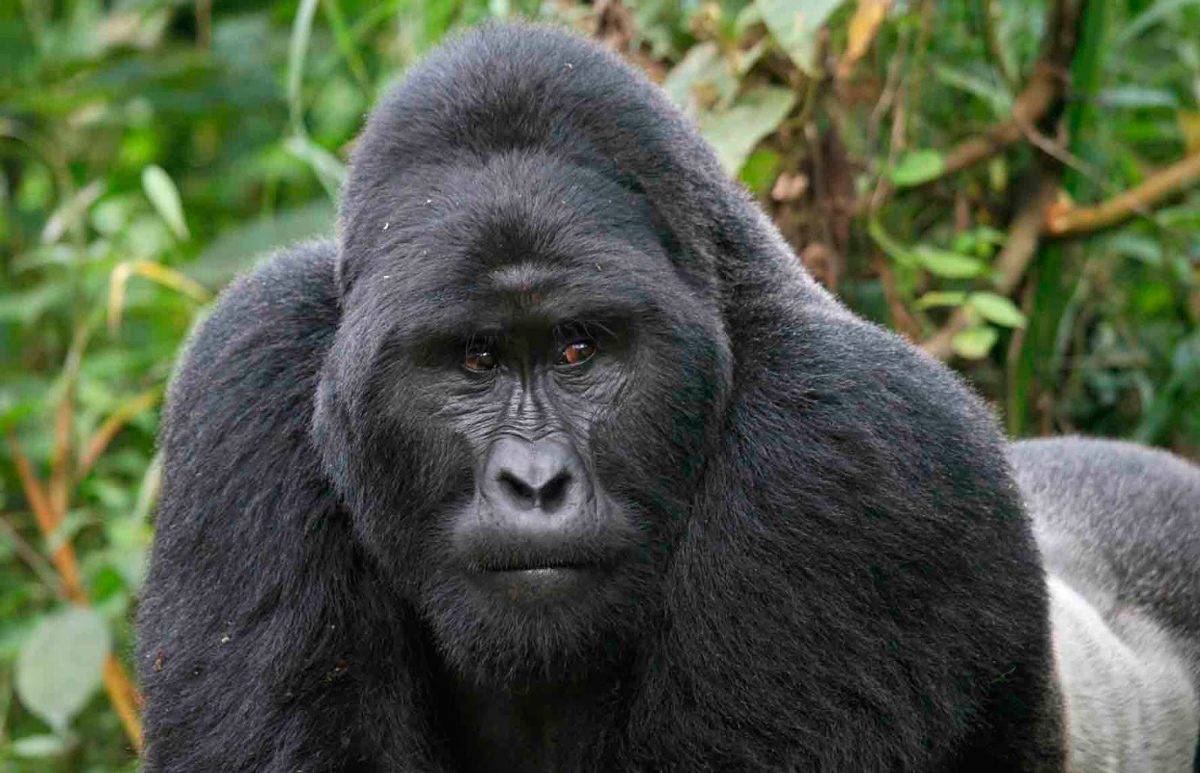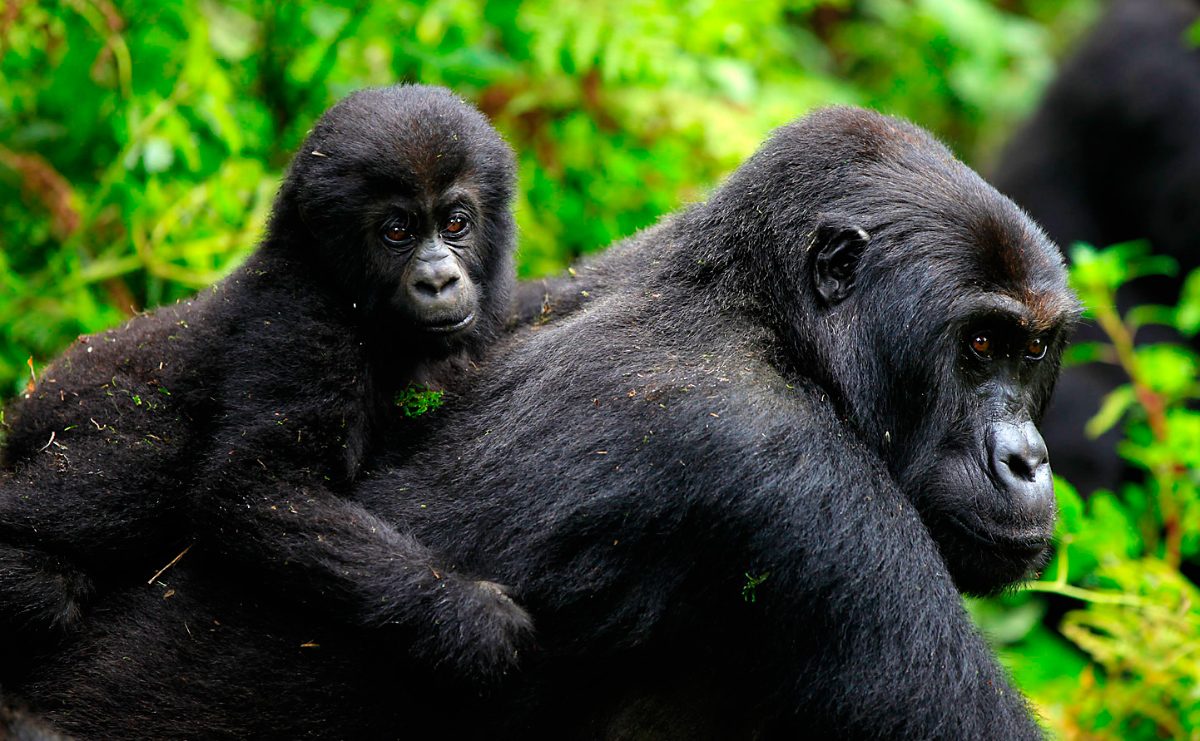The gorilla is a primate with many similarities to human beings, they are animals with enormous power, strength and size, full of great majesty. Now we will know it more thoroughly, its gorilla characteristics, types, among others.

gorilla characteristics
Gorillas measure between 1,65 to 1.75. There are cases of gorillas that have managed to measure more than this average height, reaching up to 2 meters in height. Males usually weigh between 135 to 200 kg, females only weigh half that. They are able to stand and walk on two feet, but prefer to be on 4 legs most of the time.
One of its greatest features is its protruding jaw and like human beings they also have fingerprints. In general, his blood is type B, all his senses are exceptionally developed, his sight is a clear example since the gorilla can see and differentiate all colors perfectly.
Habitat
They are found in central Africa, specifically in the Central African Republic, Congo, Cameroon, Guinea, Gabon, Uganda, Rwanda, and Nigeria. They are located in tropical forests and jungles, due to their abundant levels of flora that facilitate the task of obtaining their food.
Food
Gorillas are vegetarian animals, they consume fruits, herbs, stems and various types of plants, a small part of their diet consists of insects such as termites, ants as well as snails and caterpillars, a gorilla can consume more than 16 kilos of food per day.
Behavior
For groups of gorillas there is always a leader, who is the "silverback". He is in charge of guiding his respective group which can be up to 30 members, he takes responsibility for maintaining the order, stability and security of the group, he is the one who receives the most amount of food compared to the other gorillas, he is attributes his great strength and dominance. Compared to the others, his canines are longer and stronger.
There is the possibility that a young male or another group will challenge the alpha male, who will respond to the challenge by screaming while beating his chest hard and showing his large teeth, destroying everything around him.
The case that the alpha male dies for various reasons such as illness, fighting, hunting, among other reasons; the pack he was in charge of will split up in search of a new alpha male, a boss can take control of that pack, the offspring of the previous alpha male sometimes suffer the sad fate of being killed by the new pack boss.
When the young males separate from the group, they undertake a journey that can last up to 5 years, which can be accompanied if they wish. In this process he will look for females to mate with. Gorillas sleep from 12 to 13 hours, they do not sleep in the same place twice, they prepare a specific place for the day and another for the night, in case some young are orphaned, the alpha male of the group is in charge of their care.
Reproduction
Gorillas are polygamous, especially the "silverback" alpha male. There is no defined mating time in gorillas, females usually have their sexual awakening between 8 and 9 years of age, but they really start reproducing at 10 years of age, males reach maturity between 11 and 13 years of age .
Its gestation time lasts eight and a half months, it usually takes a time of 3 to 4 years to have another offspring, the offspring stay between 4 years with their mother, their life expectancy is on average between 30 and 50 years. , few gorillas exceed that number, the maximum at the moment is 54 years.
types of gorillas
Gorillas are divided into two types in which each has its respective subspecies. Scientists have spoken of a third subspecies of the eastern gorilla which is called gorilla bwindi, belonging to the mountains that bear the same name, but they have not received a Latin mention.
There is the western gorilla whose subspecies are the western lowland gorilla and the Cross River gorilla. Another type of gorilla is the eastern one which is divided between mountain gorilla and lowland gorilla.
Before it was believed that there was only one type of gorilla, but thanks to studies it was confirmed that the different types of gorillas separated 1,75 million years ago.
It should also be noted that the difference between the different types of gorillas is not very noticeable, they differ in their facial structure, highlighting the different shape of their nose, the eastern gorilla is taller than the western gorilla, the sound they emit to the other members of the group is also different.
intelligence level
Gorillas have been shown to have a great capacity for intelligence and understanding. Behavioral patterns have been observed in which, in their habitat, they implement different resources and materials in their day-to-day life for greater efficiency in their actions and to increase the well-being of their daily lives.
It has been observed how they can measure the depth of the water with a stick, break coconuts with stones, or defend themselves with various elements from other animals, there was even a gorilla named Koko who managed to learn sign language, without a doubt something exceptional and impressive.
Danger of extinction
This animal is currently in danger of extinction due to the high degree of damage that its habitat has presented thanks to the influence of human beings.
It also has many casualties due to hunting, many seek this animal to obtain its meat and sell them as a rare exotic alternative, having a single calf every 4 years does not help much to recover large losses, which makes seriousness very worrying of the matter in which the primate finds himself.
Do not leave without first reading the following articles:

